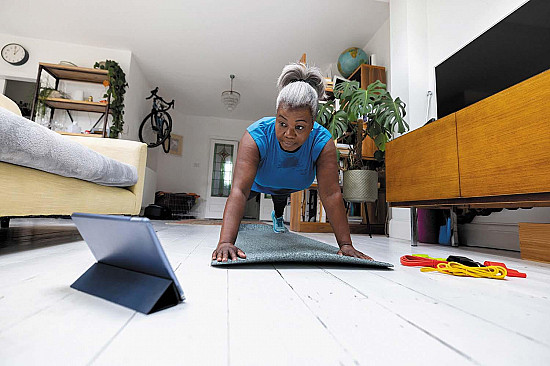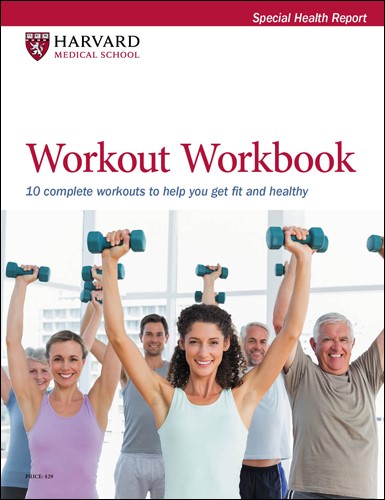6 mistakes that sabotage your workout
Try to avoid taking shortcuts, being inconsistent, and lifting too much weight too soon.
- Reviewed by Anthony L. Komaroff, MD, Editor in Chief, Harvard Health Letter; Editorial Advisory Board Member, Harvard Health Publishing

Sticking to an exercise program is a major commitment. It takes time, dedication, and hard work to reap benefits such as stronger muscles, increased endurance, better balance, and sharper thinking. The last thing you want to do is undermine your efforts.
But it’s easy to make workout mistakes that wind up hurting you, such as doing an exercise that’s too challenging or using the wrong technique while performing a particular move.
See if you recognize any of the following exercise errors, and consider ways to avoid them.
1. Skipping the warm-up
You need to warm up your muscles so they’re more flexible before you put them to work, especially as you get older and muscles and tendons are less flexible. Older muscles can tear easily because they have less water content, making them brittle and less elastic.
Avoid problems: Warm up your muscles before exercising with a few minutes of repetitive motion such as marching in place or doing arm circles. That gets blood, heat, and oxygen to the muscles and makes them ready for action.
Move of the Month: Overhead press
Stand with your chest lifted and shoulders back and down. Hold a dumbbell in each hand at shoulder height with your palms facing forward and elbows pointing out to the sides. Slowly lift the weights straight up overhead until your arms are fully extended. Hold. Slowly lower the dumbbells back to the starting position. Do this 10 times, rest for a minute, and then do 10 more. Exercise photos by Thomas MacDonald |
2. Being inconsistent
An occasional workout is less effective than more frequent activity, and cramming too much exercise into a single session can increase the risk for injury.
Avoid problems: For most people, the weekly goal should be 150 minutes of moderate-intensity exercise (that gets your heart and lungs pumping) and strength training at least twice per week. That could consist of shorter aerobic workouts (at least 20 minutes) each day or longer workouts (at least 50 minutes) three times per week.
3. Lifting too much weight
Lifting weights that are too heavy — especially lifting too much too soon, if you’re just starting to get back into a routine — can lead to muscle strains or tears.
Avoid problems: Use lighter weights and lift them more times. Do two or three sets of 20 lifts using a 2-pound weight instead of one set of five or 10 lifts with a 5-pound weight.
4. Not resting muscle groups
Working the same muscle groups every day can cause injury. Muscles need at least 48 hours after a strength workout to recover and rebuild.
Avoid problems: Alternate which muscle groups you work from day to day, such as arms and shoulders on Tuesdays and Thursdays, but not Mondays or Wednesdays.
5. Skimping on hydration
Fluids help cushion your joints and stabilize blood pressure and heart rate. Exercising causes you to lose water and electrolytes (sodium, potassium) when you sweat, and it also causes lactic acid to build up in your muscles (which can lead to muscle cramps).
Avoid problems: The amount of fluid to consume each day from food and drink depends on your body size and health needs. The National Academy of Medicine recommends about 11 cups (88 ounces) per day for women and 15 cups (120 ounces) per day for men.
If that seems steep, remember that everything you drink, including water, coffee, tea, juice, and milk — counts toward this total. The food in a balanced diet also can contribute fluid to your daily intake. For example, eating the recommended two servings of fruits and three servings of vegetables each day might provide about 15 ounces of fluid.
6. Slouching
Exercising with slouched posture and rounded shoulders may put you at risk for back and shoulder injury (such as muscle strain or tendinitis).
Avoid problems: Keep your shoulders down and back, keep your back straight, and work with a physical therapist to correct poor posture.
Want advice?
Make an appointment with a trainer or physical therapist, or check out the Harvard Special Health Report Starting to Exercise.
Image: © gradyreese/Getty Images
About the Author

Heidi Godman, Executive Editor, Harvard Health Letter
About the Reviewer

Anthony L. Komaroff, MD, Editor in Chief, Harvard Health Letter; Editorial Advisory Board Member, Harvard Health Publishing
Disclaimer:
As a service to our readers, Harvard Health Publishing provides access to our library of archived content. Please note the date of last review or update on all articles.
No content on this site, regardless of date, should ever be used as a substitute for direct medical advice from your doctor or other qualified clinician.


















